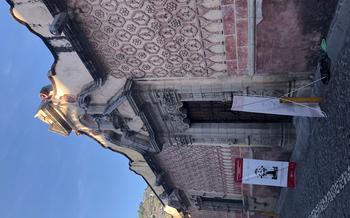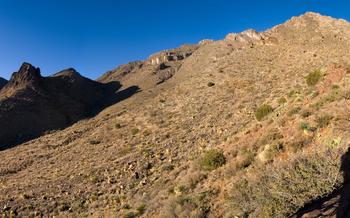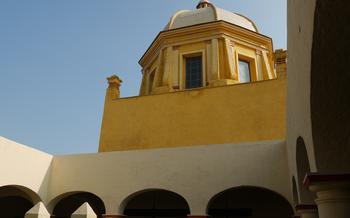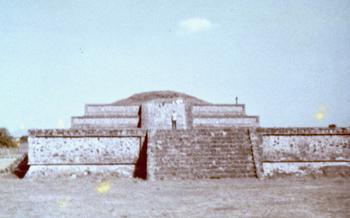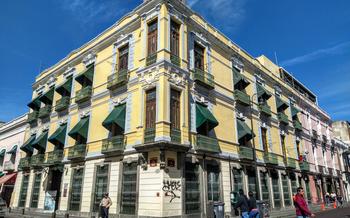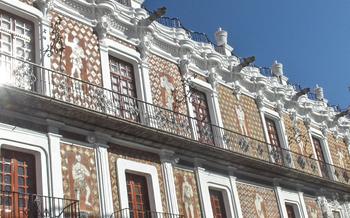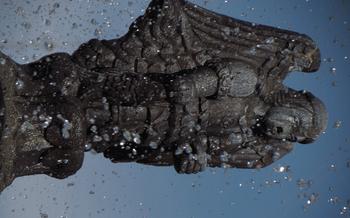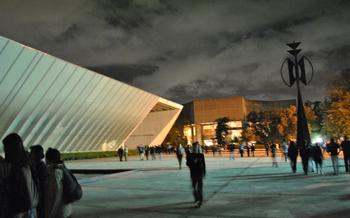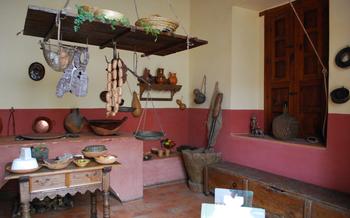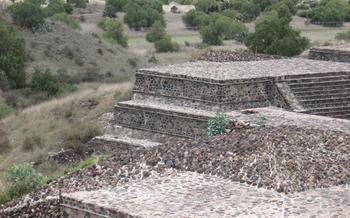
Museo Internacional del Barroco
- Historical Background: A Baroque Masterpiece in the Heart of Puebla
- Exhibitions and Collections
- Baroque Architecture: A Masterpiece of Design
- Guided Tours: Unveiling the Baroque Masterpieces
- Educational Resources: Unveiling the Treasures of Baroque Scholarship
- Temporary Exhibitions: A Dynamic Showcase of Baroque Art and Culture
- Accessibility
- Souvenir Shop: Mementos of Baroque Beauty
- Photography and Social Media
- Museum Café
- Museum Hours and Admission
- Location and Transportation
- Nearby Attractions: Unveiling Puebla's Cultural Gems
- Insider Tip: Unveiling Puebla's Baroque Gems
Historical Background: A Baroque Masterpiece in the Heart of Puebla
The Museo Internacional del Barroco (MIB) stands as a testament to the enduring legacy of the Baroque era in Puebla, Mexico. Its grand facade, adorned with intricate carvings and sculptures, hints at the treasures that lie within. Founded in 2016, MIB is dedicated to preserving and showcasing the artistic, cultural, and historical significance of Baroque art from around the world, with a particular focus on its impact on Puebla.
The museum's collection spans several centuries, encompassing paintings, sculptures, furniture, textiles, and decorative arts from the 17th to the 19th centuries. These masterpieces showcase the Baroque era's characteristic exuberance, drama, and love of detail, capturing the imagination of visitors and providing a glimpse into the artistic and cultural climate of the time.
Explore the history of the Museo Internacional del Barroco and discover the cultural significance of this architectural and artistic masterpiece. Immerse yourself in the grandeur of the Baroque era and marvel at the creativity and artistry that defined this influential period in history.
Exhibitions and Collections
The Museo Internacional del Barroco (MIB) houses an impressive array of permanent and temporary exhibitions that showcase the diverse facets of baroque art and culture. The permanent collection includes masterpieces from renowned artists such as Claudio Coello, Miguel Cabrera, and Juan Correa, who played a pivotal role in shaping the baroque movement in Mexico. These artworks encompass various mediums, including paintings, sculptures, furniture, and decorative objects, offering a comprehensive exploration of the era's artistic expressions.
Temporary exhibitions at MIB delve into specific themes or periods of baroque art, often featuring works from international collections. These exhibitions provide a fresh perspective on the movement's global influence and allow visitors to engage with new and emerging artists. The curatorial approach at MIB emphasizes interdisciplinary connections, highlighting the relationship between baroque art and other fields such as music, literature, and theater.
Interactive and multimedia elements throughout the museum enhance the visitor experience, making the exhibitions accessible and engaging for all ages. Touchscreens, audio guides, and interactive displays offer in-depth information about the artworks and the historical context of the baroque era. These interactive features bring the art to life and create a dynamic and immersive learning environment.
Baroque Architecture: A Masterpiece of Design
The Museo Internacional del Barroco showcases breathtaking baroque architecture, a style characterized by its grandeur, opulence, and intricate ornamentation. The building's facade is adorned with elaborate carvings, sculptures, and decorative elements that capture the essence of the era. Its curved lines, sweeping staircases, and domed ceilings create a sense of drama and movement.
Inside, the museum's interior design is equally impressive, with marble floors, vaulted ceilings, and walls adorned with colorful frescoes and paintings. The use of light and shadow creates a theatrical effect, highlighting the exquisite details of the architecture. Visitors can admire the intricate carvings on the wooden doors, the delicate moldings on the walls, and the ornate chandeliers that hang from the ceiling.
The unique features of MIB's architecture set it apart from other museums. Its central courtyard, with its cascading fountains and lush greenery, provides a tranquil oasis in the midst of the bustling city. The rooftop terrace offers panoramic views of Puebla's skyline, allowing visitors to admire the city's colonial architecture and the surrounding mountains.
The Museo Internacional del Barroco stands as a testament to the brilliance of baroque architecture, showcasing its grandeur, artistry, and attention to detail. A visit to this museum is a journey through time, immersing visitors in the opulence and extravagance of one of the most significant artistic movements in history.
Guided Tours: Unveiling the Baroque Masterpieces
The Museo Internacional del Barroco offers guided tours in various languages, allowing visitors to delve deeper into the intricacies of the baroque era and the museum's exceptional collection. These tours are led by experienced guides who are passionate about baroque art and architecture and eager to share their knowledge with visitors. During the tours, visitors will gain insights into the symbolism, techniques, and historical context of the artworks on display. The guides will also highlight the unique features of the museum's building, explaining the significance of its design and the stories behind the decorative elements. Whether you're an art enthusiast or simply curious about the baroque period, booking a guided tour is highly recommended, especially if you're visiting with a group. Advance reservations are advised to ensure a spot and avoid disappointment.
Educational Resources: Unveiling the Treasures of Baroque Scholarship
The Museo Internacional del Barroco (MIB) serves as a treasure trove of educational resources for scholars, students, and art enthusiasts alike. Visitors can delve into the depths of baroque art and culture through the museum's extensive library, research facilities, and educational materials.
The MIB library houses a comprehensive collection of books, journals, and periodicals dedicated to baroque art and architecture. Researchers can access a wealth of information on various aspects of the baroque period, including its history, theory, and major artistic movements.
The museum also boasts specialized research facilities, including a photography archive and a digital imaging center. These resources enable scholars to conduct in-depth studies of baroque artworks, examining details that may not be visible to the naked eye.
To foster a deeper understanding of baroque art, MIB offers a range of educational programs and workshops. These programs are designed to cater to diverse audiences, from casual art enthusiasts to seasoned art historians. Workshops cover a wide range of topics, such as baroque painting techniques, architectural analysis, and the influence of baroque art on contemporary culture.
One of the unique educational offerings at MIB is the opportunity to participate in guided research projects. Under the supervision of experienced curators and researchers, visitors can engage in hands-on research projects, contributing to the ongoing study and understanding of baroque art.
Whether you're a seasoned scholar or simply curious about the baroque era, the Museo Internacional del Barroco provides a wealth of educational resources to enrich your knowledge and understanding of this fascinating period in art history.
Temporary Exhibitions: A Dynamic Showcase of Baroque Art and Culture
The Museo Internacional del Barroco is renowned for its captivating temporary exhibitions that complement its permanent collection. These exhibitions showcase a diverse range of works by renowned and emerging artists, delving into various aspects of baroque art and culture.
Upcoming temporary exhibitions include "The Baroque in Latin America: A Legacy of Splendor," which explores the unique expressions of baroque art in different countries across the region. Another highlight is "Fashion and the Baroque: Dressing the Baroque Body," which examines the intricate relationship between fashion and the baroque aesthetic.
These temporary exhibitions offer visitors a fresh perspective on baroque art, highlighting its enduring influence and relevance in contemporary society. They provide an opportunity to discover new artists, explore different themes, and gain a deeper understanding of the baroque era.
Don't miss the chance to experience these dynamic and thought-provoking exhibitions during your visit to the Museo Internacional del Barroco. Check the museum's website for the latest exhibition schedule and plan your visit accordingly.
Accessibility
The Museo Internacional del Barroco is committed to providing an inclusive and accessible environment for all visitors, regardless of their abilities or disabilities. The museum features a range of accessibility features to ensure that everyone can enjoy the exhibitions and programs. These features include ramps, elevators, wheelchair-accessible restrooms, and signage in both Spanish and English. The museum staff is also trained to assist visitors with special needs, providing guidance and support throughout their visit. Personal experiences or observations regarding accessibility at MIB can be shared to further enhance the information provided.
Souvenir Shop: Mementos of Baroque Beauty
As you exit the mesmerizing world of baroque art, don't forget to visit the museum's gift shop, a treasure trove of souvenirs and mementos that will remind you of your visit to the Museo Internacional del Barroco. From exquisite replicas of baroque masterpieces to handcrafted jewelry inspired by the era's intricate designs, the museum shop offers a wide range of unique and exclusive items that capture the essence of the baroque era.
Whether you're looking for a small token to remember your experience or a special gift for a loved one, the museum shop has something for everyone. Browse through the shelves and you'll find an array of souvenirs, including books on baroque art and architecture, postcards featuring iconic works from the museum's collection, and decorative items that will add a touch of Baroque flair to your home.
For those who truly want to immerse themselves in the grandeur of the era, the museum shop offers a selection of high-quality replicas of famous baroque artworks. These exquisite pieces, meticulously crafted by skilled artisans, are perfect for collectors or anyone who wants to bring a piece of baroque history into their own space.
Don't miss the opportunity to take home a piece of the Museo Internacional del Barroco with you. The museum shop is a wonderful place to find unique and meaningful souvenirs that will serve as lasting reminders of your journey into the world of baroque art and culture.
Photography and Social Media
The Museo Internacional del Barroco encourages visitors to capture and share their experiences through photography and social media. Flash photography and tripods are generally not permitted inside the galleries to preserve the artworks and maintain a serene atmosphere for visitors. However, natural light photography is allowed, and visitors are welcome to take photos of the museum's architecture, exhibitions, and installations.
MIB embraces the use of social media as a platform to connect with art enthusiasts worldwide. Visitors are encouraged to share their photos and experiences on platforms like Instagram, Facebook, and Twitter, using the museum's official hashtags. By sharing their unique perspectives, visitors contribute to the museum's online community and help promote its mission to celebrate and preserve baroque art.
Museum Café
To enhance your visit, the Museo Internacional del Barroco features a charming café that offers a delightful menu and a welcoming ambiance. Indulge in a variety of local specialties and refreshments while taking a break from exploring the museum's captivating exhibits. The café's menu boasts traditional Mexican dishes, as well as international favorites, ensuring something to satisfy every palate.
As you savor the flavors of Puebla's culinary heritage, soak in the café's inviting atmosphere. With its comfortable seating arrangements and elegant décor, the café provides a perfect respite from the bustling museum. Whether you're seeking a quick bite or a leisurely lunch, the museum café is the ideal spot to relax and recharge.
Museum Hours and Admission
The Museo Internacional del Barroco is open to the public from Tuesday to Sunday, with varying hours depending on the day of the week. On weekdays, it operates from 10 am to 6 pm, while on Saturdays and Sundays, it extends its hours from 10 am to 7 pm. Visitors should note that the museum is closed on Mondays and during certain holidays, so it's advisable to check the official website or social media pages for any updates or special closures.
Admission to the museum is subject to a fee, which varies depending on the type of ticket and the age group. General admission tickets for adults cost around $10 USD, while discounted rates are available for students, seniors, and children. The museum also offers family packages and group discounts for larger parties. Visitors can purchase tickets online through the museum's website or directly at the ticket counter upon arrival.
Location and Transportation
The Museo Internacional del Barroco (MIB) is conveniently situated within the heart of Puebla, Mexico, a city renowned for its colonial heritage and vibrant culture. The museum's strategic location makes it easily accessible by various means of transportation.
To reach MIB using public transportation, visitors can take advantage of the city's efficient bus system. Several bus routes stop near the museum, including lines 3, 11, and 2Alternatively, visitors can opt for the convenience of taxis or ride-sharing services, which are readily available in Puebla.
For those arriving by car, MIB offers ample parking facilities. The museum's secure parking lot is located just a short walk from the entrance, ensuring a hassle-free visit.
MIB's proximity to other notable attractions in Puebla makes it an ideal starting point for exploring the city's rich cultural heritage. Within walking distance, visitors can discover the magnificent Puebla Cathedral, the historic Zócalo, and the colorful Talavera tile workshops. By venturing further afield, tourists can immerse themselves in the vibrant atmosphere of the city's traditional markets, sample the local cuisine, and admire the stunning architecture of Puebla's many churches and museums.
Nearby Attractions: Unveiling Puebla's Cultural Gems
Beyond the captivating walls of MIB, Puebla beckons travelers to embark on a journey through its storied past and vibrant present. A short stroll from the museum, the majestic Catedral de Puebla, with its soaring spires and intricate facade, stands as a testament to the city's architectural prowess. For a glimpse into Puebla's indigenous heritage, visit the Museo Amparo, showcasing pre-Columbian artifacts and colonial-era masterpieces.
For those seeking culinary adventures, the city's vibrant street food scene offers a tantalizing array of flavors. Sample the iconic cemitas, savory sandwiches brimming with meat, cheese, and avocado, or indulge in the sweet temptation of camotes, candied sweet potatoes.
Art enthusiasts will delight in exploring the Galeria de Arte Contemporaneo y Diseno, showcasing the works of local and international contemporary artists. To delve deeper into the city's rich history, wander through the narrow cobblestone streets of the Centro Historico, where colonial-era buildings and charming plazas narrate tales of a bygone era.
Allocate ample time to savor the essence of Puebla, a city that seamlessly blends its colonial heritage with modern-day vibrancy, ensuring an unforgettable travel experience.
Insider Tip: Unveiling Puebla's Baroque Gems
As you wander through the halls of MIB, keep an eye out for the hidden gem nestled atop the museum – the rooftop terrace. This secluded oasis offers a breathtaking panorama of Puebla's cityscape, with its iconic colonial architecture and the majestic Popocatepetl volcano in the distance. Take a moment to soak in the stunning views and appreciate the harmonious blend of baroque and contemporary design that characterizes this architectural masterpiece. Let the city's vibrant energy wash over you as you contemplate the rich history and cultural legacy of Puebla, all from this unique vantage point.
